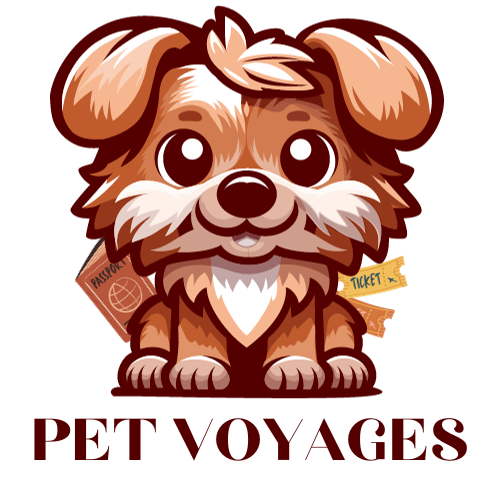So, what actually makes a pet carrier the best for air travel? It’s not about a fancy brand or a specific seal of approval. The best carrier is simply the one that ticks all of your airline's boxes while keeping your furry friend safe and sound.
Think of it this way: there's no single, universal standard for an "airline approved" carrier. The real test is whether it meets the under-seat dimensions for your specific flight, has plenty of ventilation, and features zippers that a furry escape artist can't wiggle open.
Your Guide to Stress-Free Pet Travel
Flying with a pet can feel like a huge undertaking, but having the right gear makes all the difference. The first thing to get straight is what "airline approved" really means. It’s more of a marketing term than an official certification. It suggests the carrier was designed to meet most airline requirements, but the final say always comes down to the gate agent and the specific airline you're flying with.
This puts the ball firmly in your court. You have to be the one to measure the carrier and check those dimensions against your airline’s latest pet policy. It’s like matching a key to a lock; the carrier is the key, and the airline's rules are the lock. Even the highest-rated carrier is useless if it doesn't fit. For a deep dive into navigating these rules, check out our complete guide on how to fly with pets.
In-Cabin vs. Cargo Carriers
One of the first decisions you'll make is where your pet will travel: in the cabin with you or down below in the cargo hold.
- In-Cabin Carriers: These are almost always soft-sided bags made to squish just a bit to fit under the seat in front of you. They're built for the comfort and convenience of smaller pets.
- Cargo Carriers: If your pet is too big for the cabin, they'll need a cargo carrier. These are sturdy, hard-sided crates designed to provide maximum protection and security during the flight.
Knowing which type you need is the first step, as their designs and requirements are completely different.
Key Takeaway: The "best" carrier isn't a one-size-fits-all solution. It's the perfect blend of airline compliance, a snug fit for your pet, and features that guarantee their safety. Your search should always start with your pet's measurements and your airline's rulebook, not the carrier itself.
Before you even start browsing, running through a quick checklist can save you a ton of headaches. This simple preparation ensures you find a carrier that’s not just well-made, but is the perfect match for your travel plans.
Pre-Flight Checklist for Choosing a Pet Carrier
This table breaks down the essential steps to take before you buy. Getting these fundamentals right is the secret to a smooth and safe trip for your companion.
| Checklist Item | Why It's Important | Action Step |
|---|---|---|
| Check Airline Policy | Every airline has unique size, weight, and material rules. What works for one may not work for another. | Visit your airline's official website and find their "traveling with pets" section. Note the exact under-seat dimensions. |
| Measure Your Pet | A carrier that’s too small is uncomfortable and unsafe; one that’s too big may not be allowed. | Measure your pet’s height (paws to top of head) and length (chest to base of tail). They need room to stand and turn around. |
| Assess Your Pet's Temperament | An anxious pet might try to chew or claw their way out, requiring a more durable carrier. | Consider your pet's travel history and behavior. Do you need reinforced mesh? Extra-secure zippers? |
| Identify Essential Features | Good ventilation, secure zippers, and waterproof padding are non-negotiable for safety and comfort. | Look for carriers with mesh on at least two sides, locking zippers, and a removable, washable liner. Pockets are a bonus! |
Nailing these four steps sets you up for success. It transforms carrier shopping from a guessing game into a confident choice, ensuring you get the right gear for a happy journey.
Navigating Airline Pet Carrier Rules
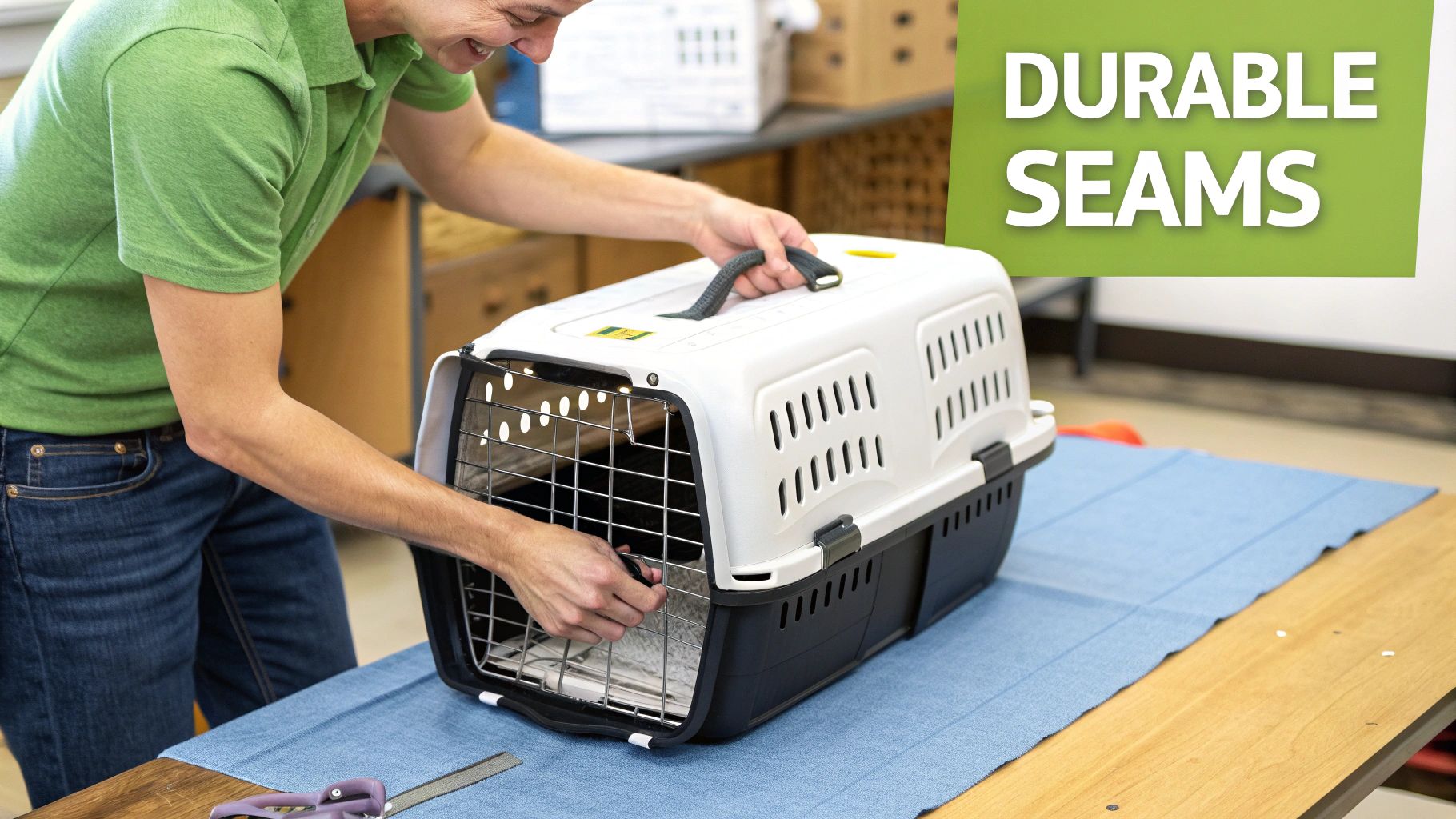
Think of airline pet policies like house keys. The key that unlocks your front door won’t work for your neighbor’s, even if the houses look identical. It’s the same with pet carriers. A bag that sails through security with one airline could get you turned away at the gate by another. This is the single most important thing to understand when you're looking for the best airline approved pet carrier.
There's no universal "approved for flight" stamp from some big governing body. The responsibility is completely on you, the traveler, to find a carrier that fits the specific—and often very strict—rules of the airline you're flying. Get it wrong, and you could be facing a heartbreaking denial right at the boarding gate.
Why Are Airline Rules So Different?
Every airline designs its planes a little differently. This means the space under the seat in front of you, where your pet will be, can vary from one aircraft to the next. Even a single inch of difference in height or width can mean the difference between getting on the plane and being left behind.
But it's not just about size. These policies are detailed safety checklists covering everything from proper airflow to how strong the carrier is. Airlines put these rules in place for the well-being of their furry passengers, so they don’t bend them.
For instance, Delta might allow a soft-sided carrier that's 18 x 11 x 11 inches, but United could require a hard carrier to be no more than 9 x 17.5 x 12 inches. Those numbers aren't suggestions; they're requirements. It hammers home just how critical it is to check the rules for your specific flight, every single time.
Decoding the Fine Print
Beyond the basic measurements, airlines have a whole list of other things they look for. It's easy to overlook these details, but doing so can quickly derail your travel plans.
Here’s what you absolutely need to look for:
- Plenty of Ventilation: Most airlines insist on mesh ventilation on at least two or three sides. A carrier with just one small mesh window probably won't cut it. Your pet needs fresh air.
- Escape-Proof Zippers: The zippers need to be strong, and ideally, have clips that lock together. Crafty pets are notorious escape artists, so flimsy snaps or Velcro closures are almost always forbidden.
- A Waterproof Bottom: A leak-proof floor is non-negotiable. It's a matter of cabin hygiene, and airline staff will often check for a removable, absorbent pad inside.
Traveler's Tip: Always, always print a copy of your airline's official pet policy and stick it in your carry-on. If an agent questions whether your carrier is compliant, you can calmly pull out the airline's own rules to back up your case.
Before you click "buy" on any carrier, you need to be confident it checks all the boxes. Our deep dive into airline pet carrier guidelines is a great place to start. A little homework upfront can turn a potentially frantic airport experience into a smooth, stress-free start to your trip.
How to Measure Your Pet for the Perfect Fit
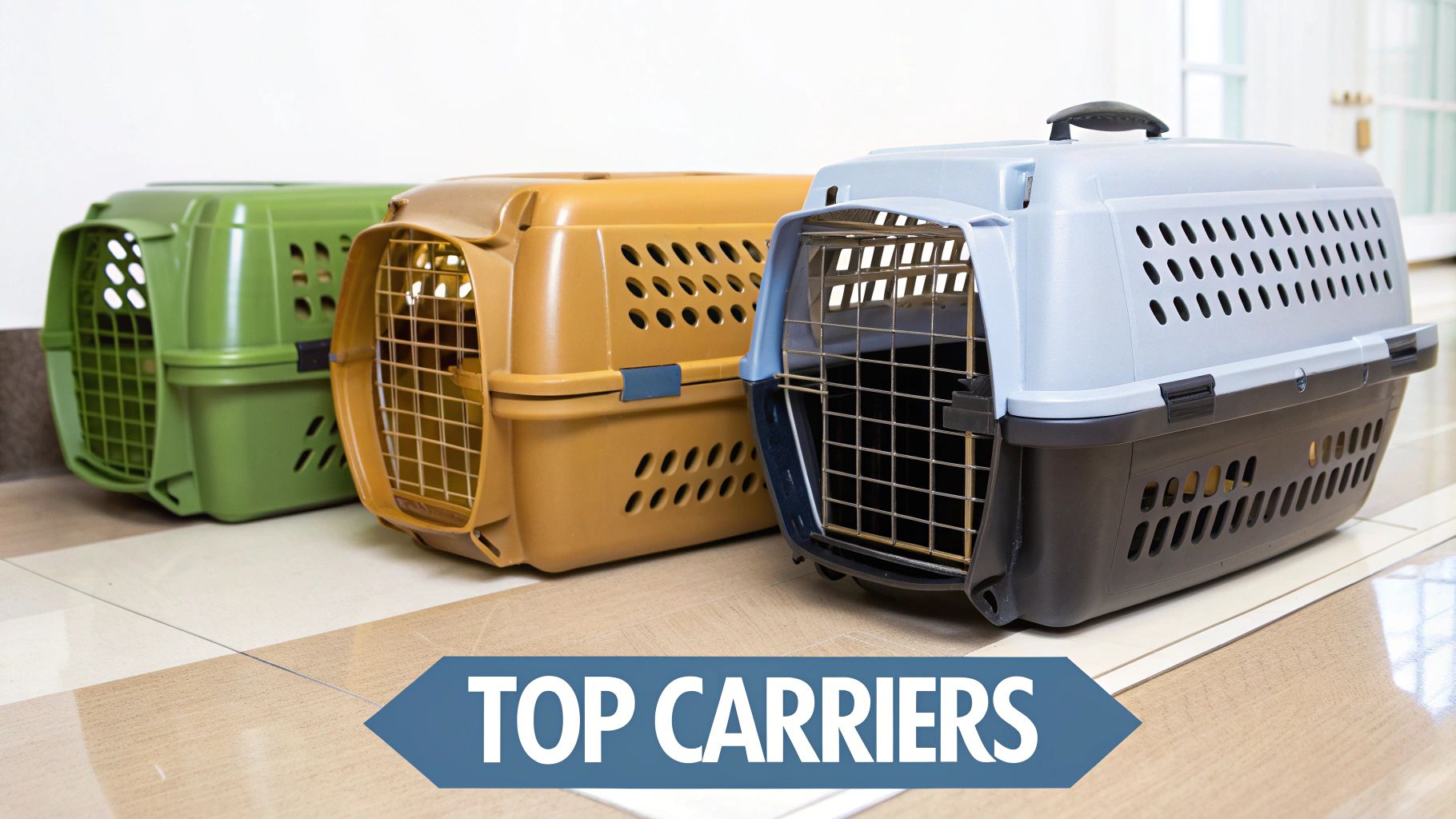
Getting a carrier that fits the airline's rules is just step one. The real test is making sure it's a good fit for your pet. A carrier that’s too tight isn't just uncomfortable—it’s a direct violation of airline policy and can be genuinely unsafe for your animal.
Every airline insists that your pet must be able to stand up and turn around inside their carrier. That’s not a friendly suggestion; it’s a hard rule, and you can bet the gate agent will check. Measuring your pet properly is the only way to find the best airline approved pet carrier that keeps everyone happy: you, the airline, and most importantly, your pet.
Think of it like getting a custom suit made. You wouldn't just eyeball it and hope it works. The same care applies here. So grab a soft measuring tape and a few treats to keep your pet cooperative, and let's get this right.
The Two Critical Measurements
To nail the perfect carrier size, you need just two numbers: your pet's length and height. It’s all about accuracy, so do your best to get your pet standing in a natural, relaxed pose.
1. Measuring Pet Length
- How to do it: While your pet is standing, measure from the base of their neck (right where their collar would sit) to the base of their tail. Be sure not to include the tail itself in the measurement.
- Why it matters: This number ensures the carrier is long enough for them to stretch out a bit and lie down comfortably, not just curl up in a ball.
2. Measuring Pet Height
- How to do it: With your pet still standing, measure from the floor straight up to the top of their head. If they have perky ears, measure to the tips of their ears—whichever point is higher.
- Why it matters: This confirms they can stand up fully without their head or ears hitting the roof, which is a non-negotiable for the airlines.
Got those two numbers? Great, you're ready to start shopping.
Pro Tip: Look for a carrier that is 2-3 inches taller and longer than your pet’s actual measurements. This little bit of wiggle room is the sweet spot—it gives them enough space to adjust their position during the flight without making the carrier too big to fit under the seat.
So, if your dog measures 16 inches long and 10 inches high, you’ll want a carrier that’s around 18-19 inches long and 12-13 inches high. This simple rule of thumb can turn a stressful trip in a cramped box into a safe and surprisingly cozy ride for your best friend.
What Really Makes a Pet Carrier Great?
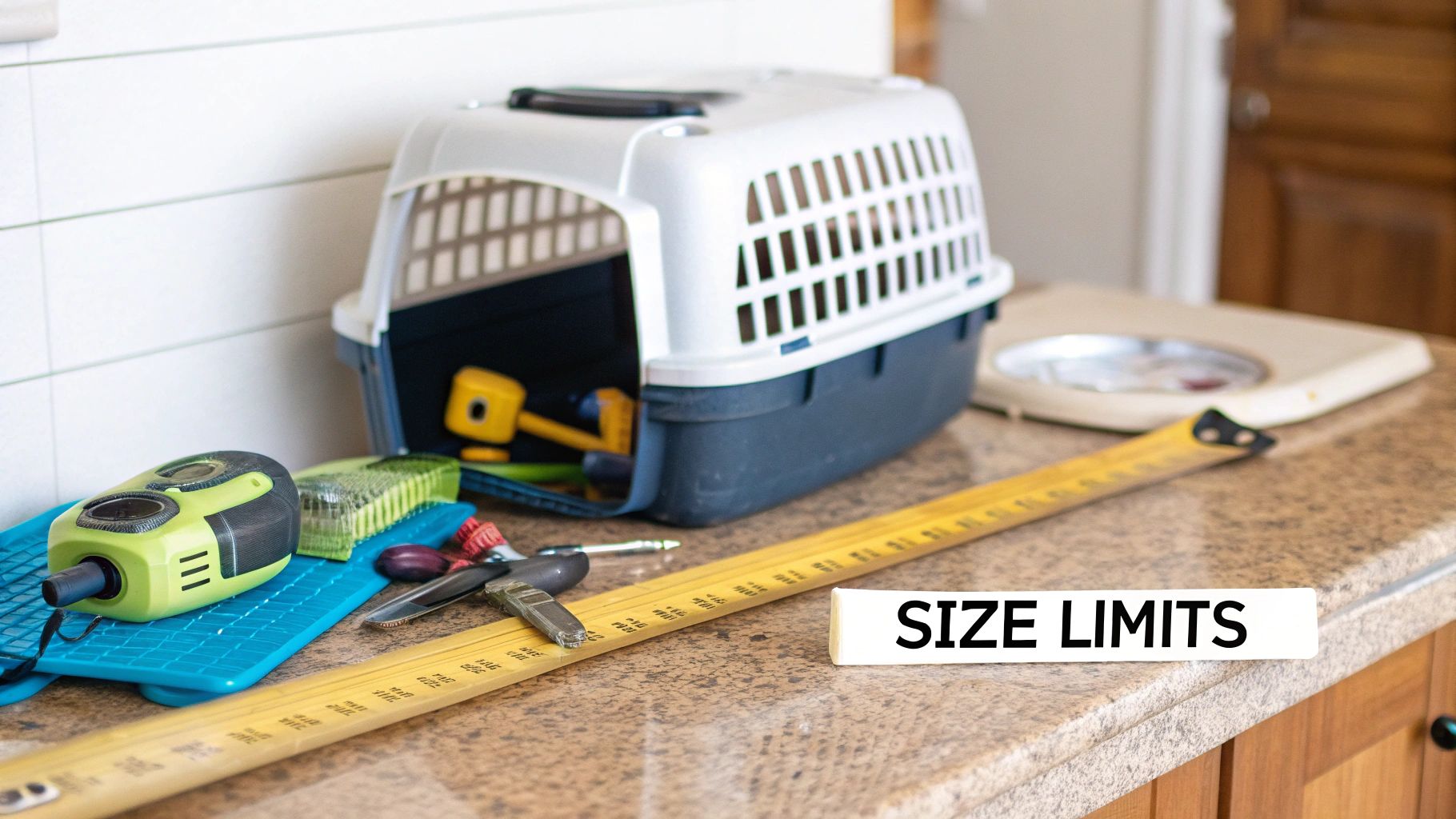
So, you've found a carrier that meets your airline’s size rules. Great! But that’s just the first checkpoint. Now the real work begins. A carrier isn't just a box; it's your pet's safe space, a little mobile den they have to trust while navigating the chaos of an airport.
Think of it like buying a car. You wouldn't just kick the tires, right? You'd check the engine, the brakes, the seatbelts—the things that actually keep you safe. A pet carrier needs that same level of inspection. We're talking about the non-negotiables: ventilation, solid construction, and escape-proof security.
Ventilation is Non-Negotiable
Let's start with the most critical safety feature: airflow. A stuffy carrier can get dangerously hot and stressful for an animal, which is exactly why airlines are so strict about it.
You need to see mesh panels on at least three sides of the carrier. This isn't just a suggestion; it's the key to creating cross-ventilation that lets fresh air move freely. A carrier with only one little mesh window is a huge red flag and will almost certainly get you turned away at the gate. Make sure that mesh is tough, too—something that can stand up to a claw or a chew without ripping.
Durability and Escape-Proof Zippers
A flimsy carrier is a disaster waiting to happen. Even the most chill dog or cat can get anxious during travel and try to make a break for it. The carrier has to be strong enough to handle some serious jostling, scratching, and pulling without falling apart.
Here's what to look for:
- Solid Stitching: Check the seams, especially around the zippers and handles. You want to see tight, reinforced stitching that looks like it can handle some weight.
- A Sturdy Frame: Even soft-sided carriers need some structure. A good one will have a rigid frame that prevents the top from sagging down on your pet.
- Self-Locking Zippers: This is a big one. These zippers have little clips that lock together, making it practically impossible for a determined paw or nose to pry them open from the inside. Standard zippers are an escape route waiting to happen.
The market for high-quality carriers is actually pretty significant, valued at around $2.5 billion in 2025. This competition pushes manufacturers to innovate with better safety features, which is why things like locking zippers are becoming more common. If you're interested in the industry trends, you can dig into the market research on airline pet carriers.
Expert Insight: Never, ever compromise on security. A carrier's main job is to keep your pet contained. If the zippers feel cheap or the seams look weak, put it back. It doesn’t matter how cute it is—it's not safe for air travel.
Comfort for Both of You
Finally, a truly great carrier is designed with comfort in mind—not just for your pet, but for you, too. You’re the one who has to haul it through the airport, after all.
For your pet, look for a plush sherpa liner that’s removable and washable. It gives them a soft place to curl up, and you can easily clean it if there's an accident. A leak-proof bottom is also a must-have for containing any spills.
For you, things like padded shoulder straps and multiple carrying handles make a world of difference when you're stuck in a long security line or trekking to your gate. Extra pockets are another lifesaver, giving you a convenient spot to stash treats, poop bags, and your pet’s paperwork.
Comparing the Top Pet Carrier Models
Okay, we’ve covered the rules and regulations. Now for the fun part: picking the actual carrier. This is where the rubber meets the road, because the best airline approved pet carrier isn't a one-size-fits-all solution.
What works for a quick, one-hour hop is totally different from what you'll need for a cross-country flight with a three-hour layover. The market is packed with choices, but for flying in the cabin, they really boil down to two main styles: standard soft-sided carriers and the increasingly popular expandable models. Let's break down which one might be right for you and your furry co-pilot.
Standard Soft-Sided Carriers
Think of a standard soft-sided carrier as the trusty workhorse of pet travel. It’s built to be durable, no-nonsense, and incredibly reliable. These carriers focus on the essentials: a sturdy, no-sag frame and plenty of ventilation to keep your pet safe and comfortable from the check-in counter to your final destination.
Their biggest selling point is their simple, robust design. Many of the best ones have a patented flexible frame, which is a game-changer. It lets you squish the carrier a bit to fit under those notoriously tight airline seats, but it springs right back into shape so it never collapses on your pet. If your top priorities are airline compliance and easy handling through a crowded airport, this is your go-to style.
Expandable Pet Carriers
Now, if a standard carrier is the workhorse, an expandable model is like a luxury RV. It’s compact and easy to manage when you’re on the move, but once you’re settled at the gate, it transforms. These carriers have zippered mesh compartments that fold out, creating a little screened-in porch for your pet.
This feature is a lifesaver on long travel days. During a lengthy layover or an unexpected delay, that extra space allows your pet to stand up, stretch their legs, and feel far less cooped up. The only real trade-off? They can be a tad heavier, and you have to remember to zip up the expandable sections before you board for takeoff and landing.
This is especially important when you consider your pet's needs during a long day of travel.
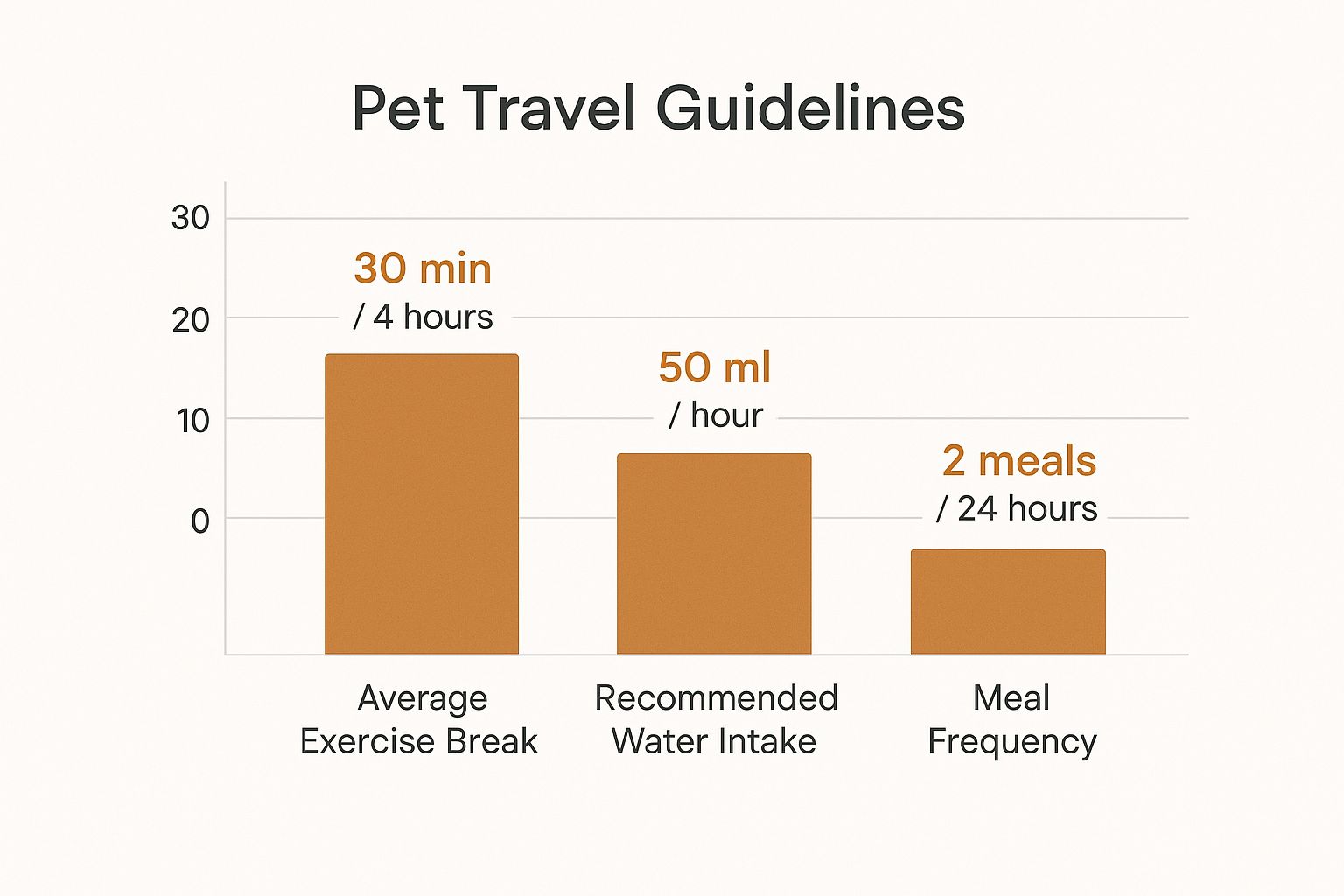
As you can see, giving your pet room to readjust is crucial. That extra space in an expandable carrier can make all the difference in their comfort and stress levels while you wait.
Feature Comparison of Leading Pet Carrier Models
To make the choice even clearer, let's look at a side-by-side comparison of a few popular carrier types. This table breaks down their features, dimensions, and the kind of travel they're best suited for, helping you match a model to your specific needs.
| Carrier Model | Type | Dimensions (Inches) | Key Features | Best For |
|---|---|---|---|---|
| Sherpa Original Deluxe | Standard Soft-Sided | 17 L x 11 W x 10.5 H | Patented spring wire frame, mesh ventilation on all sides, top & side entry, padded shoulder strap | Travelers prioritizing airline compliance and durability on direct flights. |
| PetPeppy Expandable | Expandable (2-Sided) | 18 L x 11 W x 11 H (expands to 38 W) | Dual expandable sides, plush fleece bedding, multiple pockets for storage, seatbelt loops | Long-haul travel with layovers, providing maximum space for anxious pets to stretch. |
| AmazonBasics Carrier | Standard Soft-Sided | 19.7 L x 10.2 W x 11.2 H | Soft-grip handles, machine washable fleece bed, conforms to under-seat dimensions | Budget-conscious travelers on short, infrequent trips who need a reliable basic. |
| Petsfit Expandable | Expandable (1-Sided) | 17 L x 11 W x 11 H (expands to 29 L) | Single-side expansion, self-locking zippers, lightweight design (2.4 lbs), solid base | Pet owners who want a balance of expandable comfort and a lightweight, easy-to-carry design. |
Ultimately, the goal is to find a carrier that not only meets airline rules but also serves as a safe and comfortable den for your pet throughout the journey.
Final Verdict: Go with a standard carrier if you want maximum sturdiness and portability for shorter, direct flights. Choose an expandable model if you're facing a long travel day with layovers—that extra space is pure gold for reducing your pet's stress.
If you’re looking for a solid option that balances great features with a practical design, this foldable soft-sided carrier for small to medium pets is an excellent place to start. It’s a versatile choice that handles a wide range of travel situations with ease.
Preparing Your Pet for a Calm Journey
Picking out the perfect airline-approved pet carrier is a huge win, but it’s only half the battle. The real secret to a stress-free travel day is helping your pet see their carrier not as a scary box, but as their own personal safe space. This takes a little patience and a lot of positive reinforcement, ideally starting weeks before you head to the airport.
Think about it from their perspective. You wouldn’t want to be suddenly pushed into a small, strange room and left there for hours, and neither would they. The goal is to slowly turn the carrier into a place they connect with good things—cozy naps, tasty treats, and feeling secure. This process, often called carrier acclimation, is the single best thing you can do to dial down their travel anxiety.
Creating a Positive Association
First things first, just put the carrier in a main living area of your home and leave the door wide open. Make it as inviting as possible. Toss in a favorite blanket, a well-loved toy, or even an old t-shirt that smells like you. Those familiar scents go a long way in making a new space feel safe.
Next, start feeding your pet their meals right next to the carrier. After a few days of that, move the food bowl just inside the door, and then eventually all the way to the back. This simple trick builds a powerful connection in their mind: carrier equals yummy food. Whatever you do, don't force them inside. Let their curiosity (and their stomach) lead the way.
Key Insight: A pet that walks into their carrier on their own is a pet that feels secure. Your main job is to make the carrier a voluntary, high-value spot, which will make a world of difference on travel day.
Practice Runs and Pre-Flight Checks
Once your pet is comfortable hanging out in the carrier, you can start closing the door for just a few minutes at a time while you're still in the room. Slowly make these sessions a little longer. The next step is to gently pick up the carrier and walk around the house, getting them used to the feeling of movement.
Don't forget a pre-flight vet visit. It's a must to confirm your pet is healthy enough to fly and a great time to ask about calming aids if you know you have an especially anxious traveler.
It also helps to choose an airline with a solid track record. For instance, Alaska Airlines flew over 730,000 animals in five years with an incredibly low incident rate of just 0.26. That kind of safety record can give you real peace of mind. You can always dig into pet shipping safety statistics to see how different airlines stack up.
Even after you’ve done all your homework, a few questions inevitably crop up. Getting solid answers to these common sticking points can make all the difference between a smooth travel day and a stressful one.
What Does "Airline Approved" Really Mean?
Here’s the thing: "airline approved" is mostly marketing speak. It’s not an official stamp from the FAA or any single airline. It just means the manufacturer designed the carrier with the typical airline requirements in mind—things like good ventilation, a waterproof bottom, and secure zippers.
But here's the crucial part: you still have to check your specific airline's rules. The final say always comes down to the gate agent, and they'll be looking at their airline's exact dimension and safety requirements, not the tag on the carrier.
Should I Choose a Soft-Sided or Hard-Sided Carrier?
For traveling in the cabin with you, a soft-sided carrier is almost always the way to go. Their flexibility is a huge advantage. They can squish down a little to fit under seats of varying heights, they're much lighter to lug through a sprawling airport, and frankly, they just seem cozier for your pet.
Hard-sided carriers, on the other hand, are the standard for pets traveling as cargo. They offer much more protection against bumps and shifting baggage, which is essential when your pet isn't right there with you.
Can I Use the Same Carrier for Different Airlines?
Maybe, but don't count on it. While many carriers are designed to be versatile, there's no universal size for the space under an airplane seat. A carrier that works perfectly for one airline might be a half-inch too tall for another—say, 11 inches versus 10.5 inches.
The only way to be sure is to check the specific pet policy for every single flight you book. A little due diligence before you leave home can save you a world of trouble at the check-in counter.
At Pet Voyages, we're committed to making every journey with your companion smooth and memorable. Explore our curated collection of travel essentials designed for safety and comfort. https://petvoyages.com
